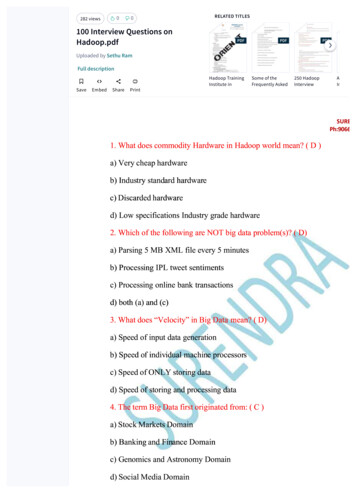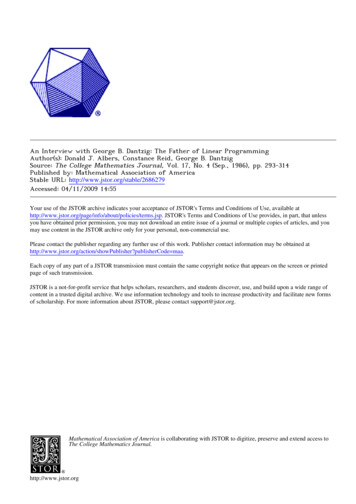
Transcription
An Interview with George B. Dantzig: The Father of Linear ProgrammingAuthor(s): Donald J. Albers, Constance Reid, George B. DantzigSource: The College Mathematics Journal, Vol. 17, No. 4 (Sep., 1986), pp. 293-314Published by: Mathematical Association of AmericaStable URL: http://www.jstor.org/stable/2686279Accessed: 04/11/2009 14:55Your use of the JSTOR archive indicates your acceptance of JSTOR's Terms and Conditions of Use, available rms.jsp. JSTOR's Terms and Conditions of Use provides, in part, that unlessyou have obtained prior permission, you may not download an entire issue of a journal or multiple copies of articles, and youmay use content in the JSTOR archive only for your personal, non-commercial use.Please contact the publisher regarding any further use of this work. Publisher contact information may be obtained herCode maa.Each copy of any part of a JSTOR transmission must contain the same copyright notice that appears on the screen or printedpage of such transmission.JSTOR is a not-for-profit service that helps scholars, researchers, and students discover, use, and build upon a wide range ofcontent in a trusted digital archive. We use information technology and tools to increase productivity and facilitate new formsof scholarship. For more information about JSTOR, please contact support@jstor.org.Mathematical Association of America is collaborating with JSTOR to digitize, preserve and extend access toThe College Mathematics Journal.http://www.jstor.org
George Bernard DaatzJg.292
AnInterviewTheby DonaldwithofFatherJ. AlbersB.GeorgeLinearDantzig:Programmingwith ConstanceReidGeorge Bernard Dantzig is rich in many ways, but as a boy growing up in theshoes. Today he and his wife Anne live in a lovelytwenties he wore secondhandhome on the edge of the Stanford Universitycampus. His study walls are coveredseveral honorary doctoral degrees, the John von Neumannwith awards, includingTheory Prize, and the National Medal of Science.are especially noteworthy in view of the trouble that he hadHis accomplishmentsin junior high school. "I was doing very poorly in my first coursewith mathematicsin algebra. To be precise, I was flunking."In 1947 Dantzig invented linear programmingand the simplex method. Dantzig'senvironmentalled to an explosion of economic,and statistical appli?programmingThe iron and steel industry has used his method to evaluate iron ores,cations.of coke ovens, and select products.The Federalthe additionEnergyexploreLinearhas used his method to explore energy policy alternatives.Administrationfor use to control water and airhas also been used or suggestedprogrammingto jobs, and racially balancingrefinery scheduling,assigning personnelpollution,schools.He respondswork is often thought of as applied mathematics.byDantzig'ssaying, "I have never been able to tell the difference between the so-called pure andthe nonpure and don't believe that there is any."in his Stanford office in Novemberof 1984.Dantzig was Okay,what shouldDantzig:Yourname is Don,MP:It's George.Dantzig:Do you rememberMP:It's Bernard.Dantzig:WhatMP:The well-knownDantzig,"Professorfor takingthanksthis "ProfessorDantzig"time to talk aboutyourselftoday.stuff?I call you?rightDo you remembermy middledoes GeorgeStuff?Dantzig"Bernardmy first name?name?suggest?writer namedGeorgeBernardShaw?That's right. My father, Tobiaswas both a writer and aDantzig:Dantzig,He hoped that I would be a writer, and so he named me aftermathematician.George Bernard Shaw. He named my younger brother Henri Poincare Dantzig afterHenri Poincare.athe great mathematicianMy brother did, in fact, becomeHe worked as an applied mathematicianfor the Bendix Corporationmathematician.until he died in 1972 at age 54.293
MP:I know your father's books, especiallyhis wonderfulLanguage of Science, but nothing much about him personally?exceptborn in Russia and studied in Paris with Poincare.TheNumber,that he wasParis is a place where professors don't pay much attention to students soDantzig:I can't say precisely what my father's relationshipto Poincare was. I do know thathe attendedhis lectures, studied his works, and admired him greatly. One of hisbooks is entitled Henri Poincare.MP:Howdid your father get to the UnitedStates?He came to this country twice, once before he married my mother. OnDantzig:that first trip he visited his aunt in South Carolina whose family owned a generalHe worked for them for a while as a peddler. He must haveapparel business.decided it had no future, for he returned to Paris. My mother, Anja Ourisson, hadat the Sorbonne at the time shegrown up in Poland and was studying mathematicsmet my father. After their marriage they emigratedto Oregon, where my fatherIn those days, gangs of young men were hired to fell treesworked as a lumberjack.and nearly worked to death. Later he had a job as a road worker. On my birthcertificate he is listed as a painter, probably a house painter. As a result of all thehard manual work, he developed huge arm muscles.MP:Howdid he manageto get back into mathematics?Dantzig:My father believed that he could never get a job in a university becauseof his heavy Russian accent; but one day at the public library he ran into Frankat Reed College, who told him heGriffin, the head of the mathematicsdepartmentwas crazy to be working as a lumberjack and road builder. Griffin assured him thatwith his academiccredentialshe could get a job in any university.That was aturning point in my father's career. He applied to Indiana University and was hired.He didn't have a formal Ph.D. at the time, but he soon acquired one while athere.professorMP:Did he quit worryingabout his accentafter that?I don't think he ever worried much about his accent. His spoken EnglishDantzig:was otherwise fluent, and he was known for his marvelous English writing style.MP:moreaboutHe obviouslyhim?was very importantin your life. Can you tell me a little bitHe was a dynamic person with a very strong personality.He knew theDantzig:classics and could quote them in Greek, Latin, and a dozen other languages. He wasan excellentteacher and quite a raconteur. In the 1920's many of his friends werein the philosophyof science. He used to hold salons in our home.very interestedFrom age eight until I was sixteen, I used to sit in the corner and listen to thesmart-alec intellectualsof the 1920's expounding.I learned a lot but said little. Aftera while I began to suspect that they really didn't know what they were talkingabout. Perhaps this explains why to this day I can never get very excited aboutideas.philosophical294
Tobias Dantzig, father of George, as a youngman. Born in Russia, he studied at the Sorbonneand later became a mathematics professor in theU.S.Anja Ourisson, mother of George Dantzig. Shestudied mathematics at the Sorbonne and lan?guages at Johns Hopkins University.Baby George?age, one year.The Dantzig brothers, Henry and George, in 1920.295
FlunkingMP:Can you rememberJuniorHighSchoolwhen your own interestAlgebrain mathematicswas aroused?Yes. I was in the ninth grade of Powell Junior High School in Washing?Dantzig:ton, D.C. My father was teaching nearby at the University of Maryland. I was doingvery poorly in my first course in algebra. To be precise, I was flunking. I rememberwalking home one day, furious with myself. How is it, I asked myself, that I, a sonof a mathematician,do poorly while all the other kids in the class do so muchbetter? I was very angry with myself. After that I sailed through algebra.MP:It soundsas if you had a lot of self-confidenceDantzig:grade hadrecoveringwas goodrememberConfidencecame slowly. My interestbeen zero. I then began to blossomfrom my poor start in algebra, I beganin math and science in high school.being interested in any other subjects.MP:Do you rememberany influentialin schoolin scienceto get topI was onby grade nine.work up to the seventhcourses. Later on, afterImarks in mathematics.the chess team. I can'tteachers?Mr. Gilbert, my mathematicsteacher at Central HighYes, especiallyI took geometryfrom him. Geometryreally turned me on. Anotherinfluence was Abe Seidenberg, who entered high school one year after Iimportantdid. We did our math together and became good friends. He is now a professor atDantzig:School.Berkeley.MP:I studiedfrom his book,Lectureson ProjectiveGeometry.The Big Prize?a photo of his classmates in the second grade. Dantzig (center of rear row)was awarded the photo for winning the long division contest. It was offered for sale but hisfamily was too poor to buy it. The only way he could get it was to win the contest.296
TenThousandProblemsGeometrywas like mother's milk to me, to quote Eliza inDantzig:ProjectivegeometryI was brought up on it. My father taught me by giving meShaw's Pygmalion.problems to solve. He gave me thousands of geometry problems while I was still inhigh school.MP:Thousands?I would say over ten thousand. After he gave me one and I came backDantzig:with a solution, he would say, "Well, I'll give you another one." It seemed as if hehad an infinite storehouse of them. At first he would check my solutions, but after awhile he would accept them as correct and just give me another, and another, andanother problem. The mental exercise required to solve them was the great gift fromthe timemy father. Solving thousands of problems during my high school days?atwhen my brain was growing?didmore than anything else to develop my analyticalpower.MP:Just workingthose problems?Dantzig:have doneYes, it was brain exercise.as well.MP:Did you ever feel that your father was pushingProblemson any other subject probablywouldyou into mathematics?Never! It was I who asked for the problems. I believe he gave them to meDantzig:just to get rid of me. It was almost as if he were saying, "Here's another problem.Now go away and don't bother me." He was always busy with whatever he was busyofcare of his students, writing, doing research, and so on. Eventually,with?takingcourse, he did run out of problems and had to go to the Library of Congress to digones.up additionalMP:So you literallyDantzig:Eventually,exhaustedyes. It seemshis supplyof problems?that he didn'thave an infinitesupplyafter all.Tobias Dantzig gave his son George a"great gift"?thousands of geometryproblems to solve.297
SecondhandMP:You mentionedwere growing up.to me earlierShoesthat there wasn'tmuchmoneywhenyouWe were always very poor. When my father taught at Johns Hopkins inDantzig:we wore secondhandshoes. In the 1920's my mother obtained a master's1919-20,degree in French from Johns Hopkins in order to qualify for a job at the Library ofShe was a linguist and a specialist in Slavic languages.Even with theCongress.income from two salaries, we were still poor. I don't remember ever having pocketmoney. There were hardly any jobs for kids. I did have a paper route once. Myatfather never earned very much. When he retired as head of the math departmentMaryland shortly after World War II, his pension was only 2,250 a year, which washalf his yearly salary. This happened just before the postwar inflation. He moved toand thatLos Angeles where he tried to pick up extra money teaching, consulting,sort of thing. Although his health was failing, he managed somehow. He never askedus, his children, for money. I don't know how he ever managed. Although he hadbeen in Los Angeles only a short time when he died in 1957, hundreds of peoplecame to his funeral. Nobody who ever met him forgot him. There was somethingmagical about the way people were attracted to him."AppliedMathematics?IBy the time you finishedin college?inmathematicsmajorMP:Didn'thigh schoolSeekit Out"was it clear to you that you wouldDantzig:Yes.MP:You said your father was teaching at the Universitywas a convenientplace to go. Was that it?Marylandof Maryland.SoI certainly had noYes, of course. It wasn't a time for high aspirations.Dantzig:dreams of going off to a fancy school which would require my family to support meaway from home.MP:Did your mathematicsstudy have a stronglyappliedflavor at that time?in any of thenot. I don't recall a single applicationNo, absolutelyDantzig:What math there was in physics andcourses I took at Maryland.mathematicschemistry was pretty primitive. I did, however, encounter an interesting applicationin a freshman chemistry course given by a Professor White. I wroteof mathematicsa little applied mathematicspaper on how to efficiently extract iodine from a wateras an extractor. He looked at it and said that itsolution using carbon tetrachloridethe carbon-tet,but that he was sureidea to subdividewas a very interestingsomeone must have already published the idea. Two years later, when I was a junior,on theand showed me a paper just publishedhe came around, very shamefaced,in the way of ansame idea. That was the only thing I ever did at MarylandI wasn't opposed to doing applied mathematics?itjust never soughtapplication.me out, and I didn't seek it out.MP:After getting your bachelor's at Maryland in 1936, you went to Michiganfor graduate study. Did you take any statistics at Michigan?and R. L.Dantzig:Mainly I studied under G. Y. Rainich, T. H. Hildebrandt,Wilder. I did take a statistics course with H. C. Carver. In the summer of 1936 Imarried Anne Shimmer, and she came to Ann Arbor with me. We earned money298
Dantzig as a graduate student in Michigan.Newlyweds Anne and George Dantzig enjoying a picnic in Michigan in 1937.on the side for a flour company. Theworking for Carver. He did some consultingwanted to buy large quantities of wheat in the commoditymarket duringcompanythe year at prices that would average out to the average annual price. Carver workedout a system of hedging that was supposedto be sensational.He swore me tothewascarefultotheworksheetsso that I wouldhesame,secrecy; justcamouflagenot discover his secret regression formula.Statistics as taught by Carver seemed to me just a bag of tricks?itdidn't erythingMichiganterriblyabstract?soabstract that I had but one desire: to quit my graduate studies and geta job, which I did.299
MP:So that's when you went to Washington,D.C?Yes. By luck?thatwas 1937, still the Depression?IDantzig:got a job as aclerk with the Bureau of Labor Statistics. The job I took, although at astatisticallower civil service grade, was the one that had recently been vacated by MiltonFriedman. I was assigned to a project called "Urban Study of Consumer Purchases"and asked to review a paper on double sampling by the famous statisticianJerzywho was then at UniversityNeyman,College in London. It was my first encounterwith statistical theory based on a logical rationale. I was very excited by the paper.it was the least representativeof Neyman'scontributions.I amLater I discoveredI would have become evensure that if I had seen anything more representative,more excited.MP:Did you like your work at the Bureauof Labor Statistics?Our group was veryYes, I learned a lot about practical applications.Dantzig:good. My co-worker was Duane Evans. He and I became good friends. Later Evans'model of the U.S.Leontief'swork in World War II on Wassilyinput-outputeconomychanged the course of my career.MP:So then how did you get from the Bureauyou really moved around!to Berkeley?Like your father,In retrospectI don't think I moved around too much. While at theDantzig:Bureau, I wrote to Neyman, who was by then at Berkeley, and told him that I wouldlike to finish my Ph.D. under him. At Berkeley in 1939, statistics was still part of theso the focus was on pure mathematicsand not onmathematicsdepartment,that I was everstatistics.The total number of courses in theoreticalstatisticsexposed to was two given by Neyman.MP:What was Neymanlike as a person?had a dominatingthat he was able to assert longDantzig:Neymanpersonalityafter he had been officially retired. In his seventies and eighties, he continued to runthe statistical laboratory at Berkeley. No one dared to contradict him. He was topthat he was a tyrant. Hedog in every sense. I don't want to give the impressionwasn't. He was very likeable?everyonerespected him as the leading mathematicalin the world, quite correctly, I think.statisticianJerzy Neyman was "top dog in everysense" according to Dantzig.300
Howto Geta Ph.D.?DoYourHomework!MP:How did it happen that you did your Ph.D.you took so few courses in statistics?on a statisticaltopicwhenIt happened because during my first year at Berkeley I arrived late oneDantzig:classes. On the blackboardthere were two problems that Iday at one of Neyman'sassumed had been assigned for homework. I copied them down. A few days later Ifor taking so long to do the homework?theto Neymanproblemsapologizedseemed to be a little harder to do than usual. I asked him if he still wanted it. Hetold me to throw it on his desk. I did so reluctantly because his desk was coveredwith such a heap of papers that I feared my homework would be lost there forever.About six weeks later, one Sunday morning about eight o'clock, Anne and I wereHe rushed inawakenedby someone banging on our front door. It was Neyman.to one of yourwith papers in hand, all excited: "I've just written an introductionFor a minute I hadpapers. Read it so I can send it out right away for publication."no idea what he was talking about. To make a long story short, the problems on theblackboardthat I had solved thinking they were homework were in fact two famousin statistics.That was the first inkling I had that there wasunsolvedproblemsanything special about them.MP:But you had apologizedto Neymanfor takingso long to do them.and you know how graduateWell, there was no particular deadline,take their time. A year later, when I began to worry about a thesis topic,Neyman just shrugged and told me to wrap the two problems in a binder and hewould accept them as my thesis.until after WorldThe second of the two problems, however, was not publishedWar II. It happenedthis way. Around 1950 I received a letter from Abraham Waldthe final galley proofs of a paper of his about to go to press in the AnnalsenclosingMathematicalStatistics. Someone had just pointed out to him that the main resultofin his paper was the same as the second "homework"problem solved in my thesis. IHe simply inserted my name asthat we publish jointly.wrote back suggestingcoauthor into the galley proof.Dantzig:studentsHomeworkandReligionMP:Is it true, as I have heard, that the story of your "homeworkhas been used by ministers in sermons?problems"so. The other day, as I was taking an early morning walk, IDantzig:Apparentlywas hailed by Don Knuth as he rode by on his bicycle. He is a colleague at Stanford.was visiting in Indiana recently and heard aHe stopped and said, "Hey, George?Isermon about you in church. Do you know that you are an influence on Christians"theof middle America?" I looked at him, amazed. "After the sermon," he went on,minister came over and asked me if I knew a George Dantzig at Stanford, becausethat was the name of the person his sermon was about."MP:Howdid that happen?The origin of that minister's sermon can be traced to another LutheranDantzig:Schuler of the Crystal Cathedral in Los Angeles.Severalthe Reverendminister,heIandyears agohappened to have adjacent seats on an airplane. He told me hisand I told him my story about the homeworkideas about thinking positively,and my thesis. A few months later I received a letter from him askingproblems301
to include my story in a book he was writing on the power of positivepermissionSchuler'sbut essen?thinking.published version was a bit garbled and exaggeratedtially correct. The moral of his sermon was this: If I had known that the problemswere not homeworkbut were in fact two famous unsolved problems in statistics, Iwould have become discouraged,andprobably would not have thought positively,would never have solved them.WorldMP:WarII andDid you finish your Ph.D.AirForcePlanningat Berkeley?Not quite. I had completed my course work, and my thesis was settled inDantzig:June 1941. But I had not defendedmy thesis or my minor thesis on dimensiontheory. This was six months before Pearl Harbor. Many of us wanted to contributeto World War II, which we believed the U.S. was about to enter. I went back toand had an interviewwith Charles Batesduring summer vacationWashingtonwho had been selected by Secretary Lovett to set up Air Force"Tex" Thornton,The Air Force at that time did not have a good system forStatisticalControl.reporting the status of their aircraft. They didn't even know their total number ofplanes, which at the time was less than 100. The interview took place on the cornerof 20th Street and ConstitutionAvenue. He wanted me to join him right away. Mywife, Anne, who was with me at the interview, is very good at spotting talent. Shetold me Thornton was a man who was going places and I should take the job. Shewas right. As you know, after the war Tex founded Litton Industries.MP:subject,So it was your work with the Air Force that got you into this now famouslinear programming?Not exactly right away. I stopped my graduate studies and joined the AirDantzig:Force as a civilian. I was put in charge of the Combat Analysis Branch of StatisticalControl. I set up a reporting system for combat units on the number of sorties flown,aircraft lost and damaged, bombs dropped, and targets attacked. I became quitemethodsat programmingthe onlyma?expertplanningusing"computingchines" we had then?peopledesk calculators.using hand-operatedin the PentagonincludedBrandonBarringer(a well-knownMy colleaguesbanker), Robert McNamara(of World Bank fame), Edward LearnedPhiladelphiaat New York(of the Harvard Business School), and Warren Hirsch (the probabilistwhowasmy rammingIn spring 1946 I returned to Berkeley and finished my Ph.D. I turned down anoffer from Berkeley because it paid too little and returned to the Pentagon, where Iadviser to the U.S. Air Force Comptroller.But I was reallybecame the mathematicallooking for an academic position. To entice me into remaining with the Air Force,two of my colleagues, Dal Hitchcock and Marshall Wood, challenged me to see whatcould be done to mechanize the planning process; that is, to find a more rapid wayto computea time-stagedtraining, and logisticalsupply program.deployment,in those days meant using analog devices or punch-cardMechanizationequipment.I set out to formulate a model. Iwith my training as a mathematician,Consistentwas fascinatedby the work being done at the Bureau of Labor Statistics by Duaneand Marvin Hoffenbergon the input-outputmodel ofEvans, Jerome Cornfield,302
atWassily Leontief. I had learned about it during the war in telephone conversationswere much too busy during the day to talk.night with Duane Evans?weIn my Linear Programming and Extensions you will notice that I pay great tributethe Inter-industryIt was Leontief who around 1932 first formulatedto Leontief.Model of the American Economy, organized the collection of data during the Greatand finally tried to convince policy makers to use the output from theDepression,andAll of these things are necessarysteps for successfulapplications,analysis.Leontief took them all. That is why in my book he is a hero.Leontief s model had a matrix structure which was simple enough in concept withsufficient detail that it could be useful for practical planning. I soon saw that it hadmodel and what was needed was aLeontiefswas a steady-stateto be generalized.time. In his model there was aoveronecouldthatchangehighly dynamic model,and the items ondenceWhat was needed was a model with many alternativeduced by the processes.the applicationhad to be large scale?withactivities.hundreds, perhapsMoreover,In other words,of activities and items. Finally, it had to be computable.thousandsthere had to be a practical way to compute whatonce the model was formulated,with theirto engage in so as to be compatibleof these activitiesquantitieswould becharacteristicsand given resources. The model I formulatedinput-outputdescribeddynamic linear program with a staircase matrixtoday as a time-stagedstructure. Initially there was no objective function, in other words no explicit goal.Such goals did not exist in any practical sense because planners simply had no waythem.to implementAnEarthFilledwithComputersa planningA simple example illustrates the fundamentaldifficulty of formulatingof nalysisprogram usinging 70 men to 70 jobs. An "activity" consists of assigning the /th man to the y'thare (a) that there are 70 men, each of whom must be assigned,job. The restrictionsand (b) that all of the jobs, also 70, must be filled. The level of an activity is either 1,meaning it will be used, or 0, meaning it will not. Thus there are 2 X 70, or 140,zero-onewith 4900 correspondingand 70 X 70, or 4900, activitiesrestrictionsor waysthere are also 70 factorial permutations,decision variables.UnfortunatelyThe problem is to compare these 70 factorial ways and toto make the assignments.select the one which is optimal, or "best" by some criterion.Now in this example 70 factorial is a very big number. To get some idea of howcomputer available at the time of thebig, suppose we had had an IBM main-framebeenthen and now?haveWouldit?betweenmillionfifteenyears ago.Big BangNo! But suppose that an even moreall the possible solutions?able to examineone billionhad been available, one that could have examinedcomputerpowerfulassignmentsper second. The answer would still be no. Even if the Earth were filledwith nanosecond-speedcomputers, all working in parallel, the answer would still beno. If, however, there were ten Earths, all filled with nanosecond-speedcomputers,in parallel from the time of the Big Bang until the sun grows cold,all programmedthen perhaps the answer would be yes. The remarkablething is that the simplexmethod with the aid of a modern computer can solve this problem in a split second.This example illustrates why, up to 1947 and for the most part up to this day, agreat gulf exists between man's aspirations and his actions. Man may wish to statebut there are so many ways tohis wants in terms of an objective to be extremized;303
that it has beengo about doing the job, each with its advantages and disadvantages,tothemandtothemthatonewhichchooseis best. So,impossiblecompareamongman has always had to turn to a leader whose "experience"and "matureinvariably,would guide the way. The leader's guidancein thejudgment"usually consistedof a series of edicts or ground rules to those developingissuancethe programs.such methods are still widely used, the world today is far too complex forAlthoughsuch simplistic methods to work, and they don't.In late 1946, before we knew that high-speedelectronicwere sooncomputersa mathematicalmodel that satisfactorilygoing to exist, I had formulatedrepre?in practice. However, in placesented the technologicalrelations usually encounteredof any explicitly stated goal, or function to be extremized, there were a large numberof ad hoc ground rules issued by those in authority to aid in the selection of theto choose from the astro?solution.Withoutthese it would have been impossiblenomical number of feasible solutions.MP:MostThat certainly has to be classedmathematiciansprefer problems whichas a very messy real-worldare cleanly formulated.problem.for someone coming from a purely mathematicalIt is almost impossibleDantzig:withtohow to go aboutlittleto understandexposurebackgroundapplicationsa real-world problem in mathematicalterms. There is a certain softnessformulatingin the definition of many "dirty" real-world problems, which?a lack of precision?When I saymathematicalformulations.them to have many tone-to-oneequivalent"equivalent,"but equivalent for the purpose of the application.From the pointcorrespondence,of view of the person looking for an answer, one definition of the problem may beas another. But one definition may turn out to be completelyjust as satisfactoryto mathematicalamenableanalysis and solution while another may be mathemati?of the problem can one decideOnly through detailed knowledgecally hopeless.is just as acceptable.Linear programmingwhether the more tractable formulationwith them many large problemsmodelshave been successfulbecausecan beformulatedso that they are acceptable to planners and solvable on a computer.TheMP:you'reYoungYou are oftencomfortablewith?Fathercalledof Linearthe FatherProgrammingof LinearProgramming.Is that a titleI have to tell you a story. Twenty-fiveDantzig:years ago I visited Japan for thefirst time. When I got off the plane, the Japanese who met me were very surprised athow young I was. Since I had been billed as the Father of Linear Programming,theyto see an old man with white hair and a cane being helpedexpectedapparentlydown the ramp. I was 45 at the time.MP:The preface to your book Linear Programmingand Extensionsopenswith a provocativestatement: "The final test of a theory is its capacity to solve theproblems which originated it."Dantzig:Did I say that? It's a great quote.MP:Your secondthe theory and solutionbe just as interestingtoCuriouslyenough, until304Show me where.withparagraph isn't bad either: "This book is concernedof linear inequality systems. On the surface, this field shouldas its special case, linear equation systems.mathematicians1947 linear inequalitytheory generated only a handful of
The Father of Linear Programminglecturing in Japan.papers, while linear equations and the related subjects of linear algebra andtheory had developed a vast literature. Perhaps this disproportionateapproximationinterest in linear equation theory was motivated more than mathematicianscare
The Father of Linear Programming by Donald J. Albers with Constance Reid George Bernard Dantzig is rich in many ways, but as a boy growing up in the twenties he wore secondhand sho



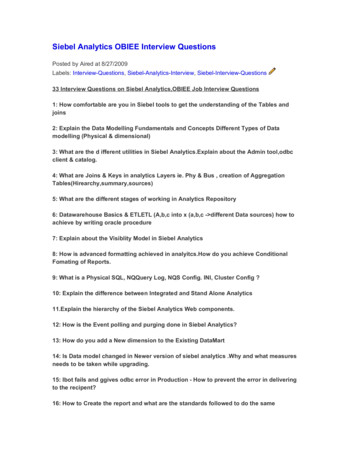
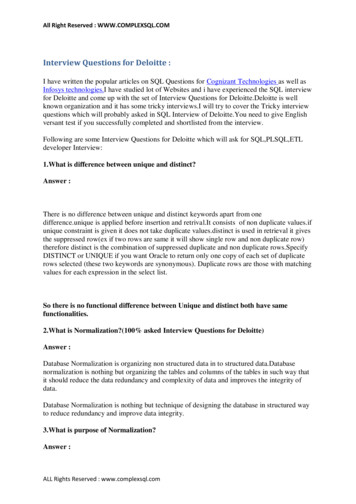

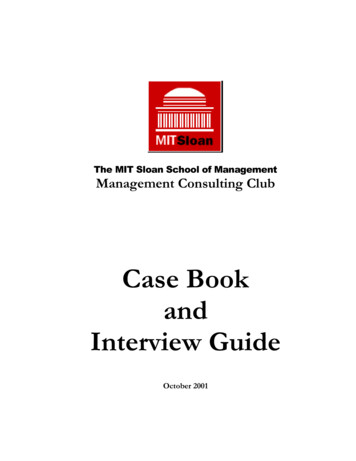
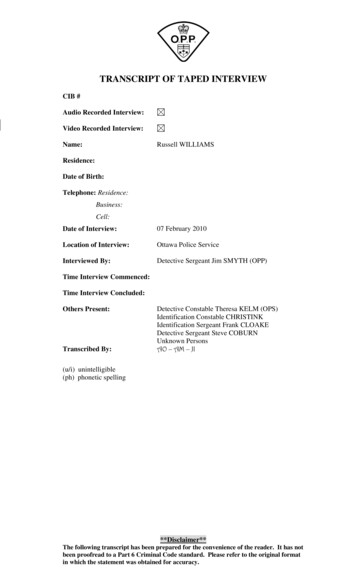
![Informatica Interview Questions and Answers [Scenario-Based]](/img/2/informatica-interview-questions-and-answers-scenario-based-1.jpg)

